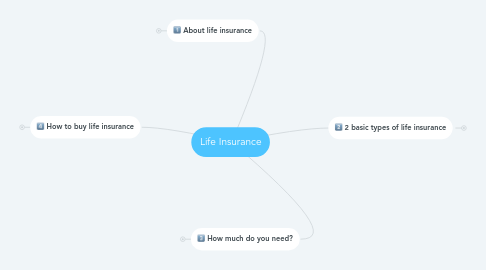
1. How much do you need?
1.1. Financial needs @ death
1.1.1. final expenses
1.1.1.1. 1-time expenses @ death
1.1.1.1.1. funeral is largest expense
1.1.2. income-replacement
1.1.3. readjustment-period
1.1.4. debt-repayment
1.1.5. college expense
1.2. 3 ways to meet above needs
1.2.1. existing assets
1.2.1.1. savings, investments in stocks, bonds, mutual funds etc.
1.2.2. government benefits
1.2.2.1. social security survivor benefits
1.2.2.1.1. usually < $1,000/month
1.2.3. Life insurance
1.2.3.1. paid to beneficiary
1.2.3.1.1. person designated in policy to receive funds
1.3. 2 methods to determine how much you need
1.3.1. multiple-of-earnings approach
1.3.1.1. addresses only income-replacement needs
1.3.2. needs approach
1.3.2.1. considers all needs
1.3.2.2. best approach
2. 2 basic types of life insurance
2.1. Term
2.1.1. pays death benefit if insured dies within policy period
2.1.1.1. policy periods are for 1,5,10, or 20 years
2.1.2. called "pure protection"
2.1.3. Face amount
2.1.3.1. $ value of protection
2.1.4. Types:
2.1.4.1. Guaranteed renewable
2.1.4.1.1. can renew regardless of health
2.1.4.2. Level-premium
2.1.4.2.1. premium stay the same during life of policy
2.1.4.3. Decreasing
2.1.4.3.1. face amount declines annually
2.1.4.3.2. premiums stay the same
2.1.4.4. Convertible
2.1.4.4.1. option to go from term to cash-value policy
2.1.4.5. Group
2.1.4.5.1. issued through employers
2.1.4.6. Credit
2.1.4.6.1. pays remaining balance of a specific loan
2.1.4.7. Mortgage
2.1.4.7.1. pays off mortgage debt
2.2. Cash-value
2.2.1. 2 components:
2.2.1.1. payment of death benefit
2.2.1.1.1. uses a decreasing term insurance
2.2.1.2. savings/investment element
2.2.1.2.1. uses an investment account
2.2.1.2.2. helps while policyholder is still alive
2.2.1.3. the above 2 add up to the face value of the policy
2.2.2. also known as "permanent" insurance
2.2.3. Types:
2.2.3.1. Whole life
2.2.3.1.1. lifetime coverage as long as premiums paid
2.2.3.1.2. most popular type
2.2.3.2. Limited-pay whole life
2.2.3.2.1. allows premium payments to stop before age 100.
2.2.3.2.2. 2 types:
2.2.3.3. Adjustable life
2.2.3.3.1. allow you to adjust 1 of 3 componets:
2.2.3.4. Modified life
2.2.3.4.1. low premiums in early years of policy
2.2.3.4.2. higher premiums in later years of policy
2.2.3.5. Universal life
2.2.3.5.1. 3 features:
2.2.3.6. Variable life
2.2.3.6.1. allows you to choose
2.2.4. Policy features
2.2.4.1. policy illustration
2.2.4.1.1. shows projected growth of cash-value
2.2.4.2. nonforfeiture values
2.2.4.2.1. amount of policy that protects the policyholder in case premiums are not paid
2.2.4.3. policy loans
2.2.4.3.1. can borrow all or part of accumulated cash value of policy
2.2.4.4. waiver of premium
2.2.4.4.1. if policyholder becomes disabled or seriously ill, no premiums have to be paid
2.2.4.5. guaranteed insurability
2.2.4.5.1. allows purchase of more life insurance without health exam
3. About life insurance
3.1. terms
3.1.1. policy
3.1.1.1. contract between insured & life insurance company to pay policy benefits
3.1.1.2. to designated beneficiary at insured's death
3.1.2. owner/policyholder
3.1.2.1. has rights to amend policy & change beneficiary
3.1.3. insured
3.1.3.1. person whose life is insured
3.1.4. beneficiary
3.1.4.1. person receiving death benefit
3.1.5. incontestability clause
3.1.5.1. time limit for insurance company to deny a claim
3.1.6. suicide clause
3.1.6.1. if insured commits suicide < 2 years after policy issued, will not pay claim
3.1.6.2. premiums will be refunded
3.1.7. settlement options
3.1.7.1. determine how death benefit will be paid
3.1.7.2. best option
3.1.7.2.1. lump sum
3.1.8. low-load life insurance
3.1.8.1. has low sales commissions
4. How to buy life insurance
4.1. as part of financial planning
4.1.1. 2 components
4.1.1.1. term insurance
4.1.1.2. systematic regular investment program
4.2. buy online
4.2.1. premium quote service
4.2.1.1. comparisons from 20-80 companies
4.3. local insurance agent
4.4. 2 methods for comparing similar quotes
4.4.1. interest-adjusted cost index
4.4.2. interest-adjusted net payment index
